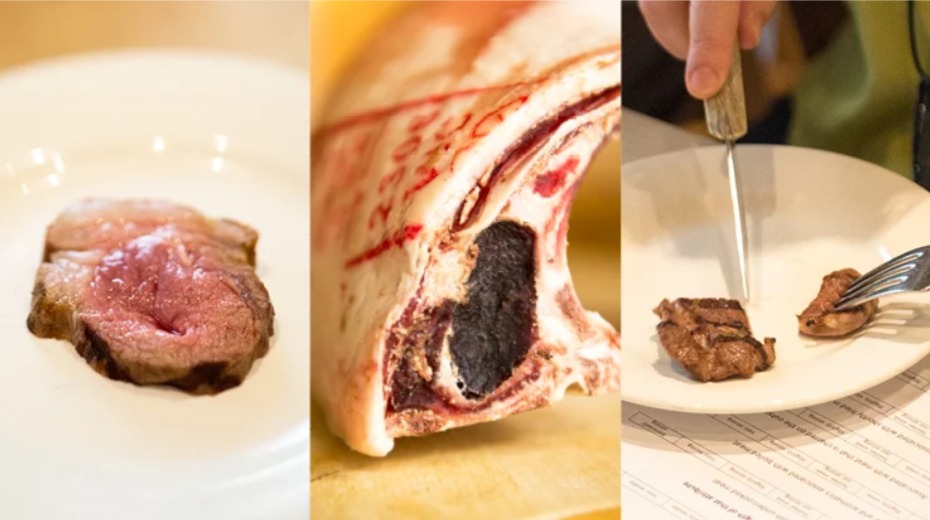
Melbourne research has shown potential for aged mutton.
VICTORIAN research has highlighted the potential for the production and marketing of premium aged mutton products.
Meat & Livestock Australia said new research is looking into the emerging trend of dry-aged mutton and how producers could one day take advantage of potential premiums.
Pilot research on dry ageing sheep meat with South Australian-based restaurateur Tim Burvill evolved into a new MLA-funded project to examine if dry-aged mutton could be a lucrative market for Merino producers.
University of Melbourne researchers Professor Robyn Warner, Hollis Ashman and Melindee Hastie managed the project, which found meat from five to eight-year-old Merino ewes was desired by consumers and could attract a premium of $35/kg.
The project focused on:
gathering market insights
development of a best practice process for dry ageing sheep meat by testing the eating quality and willingness of consumers to pay for it
the needs of consumers and end users.
It involved processing 81 multi-purpose Merino ewes supplied by Ben Duxson of Marnoo, Victoria. Carcasses from the 3-8 year-old ewes were dry and wet aged for two, four, six and eight weeks.
“The multi-purpose Merino is an animal bred for wool and meat production with genetic traits supporting both.
“After 2000 or 3000 happy days on earth, our ewes may no longer be of value for reproduction but, as they were bred for their meat as well, can offer a high quality carcase,” Mr Duxson said.
“Dry ageing was seen as a means of improving the eating quality of sheep meat now considered mutton and helping it become a niche eating experience.”
Rack and loin mutton cuts rated highly
Taste testing using the Meat Standards Australia tasting protocols was conducted with 540 consumers from a range of different cultural backgrounds eating their way through 3240 samples of loin and leg cuts.
As a group, the consumers weren’t able to detect the difference between wet and dry aged mutton; however, on segmenting the groups by cultural heritage, it was found those of a European heritage preferred the dry-aged meat.
Market research found Asian and Australian consumers identified dry-aged mutton as a premium offering. While Australians tended to enjoy it more as a standalone ingredient, Asians saw it as a component of a dish. Australians were also keener on the leaner cuts, while Asian consumers went for marbling. Both groups rated the rack/loin cuts highly.
Mutton has different cooking requirements
MLA said the project also engaged chefs to develop cooking and utilisation recommendations and to showcase the product to food service. They found mutton had different cooking requirements to lamb and was ideally suited to slow braise and sous vide cooking techniques.
“A challenge we had was to optimise the value from dry ageing a whole carcase, so the project established ideal ways to utilise every cut like rumps were ideal for sous vide and mince was a good option for convenience and versatility,” Ms Hastie said.
The research found a high yielding carcase with a fat score of 3 or more is ideal. To minimise shrinkage, dry ageing a whole mutton carcase is advised; however, there’s no benefit to dry ageing shanks as they lose too much yield.
You would need plenty of old ewes – Duxson
Mr Duxson also participated in the taste testings and said he was blown away by the quality of the product and said this research paves the way for a producer or processor with scale and capacity to create a high quality product.
“I’d love to do it but I think once the product gets out there, the demand will be pretty big and you need to have plenty of old ewes consistently available to supply the market.”
Source: MLA.



Are MLA going to actually put some producer money back into marketing mutton in the domestic marketplace?
As a consumer I would love to be able to purchase mutton as a cheaper alternative at the supermarket. And coming from a producing family, it is something that I’ve eaten all my life, although not not dry aged.
No matter what the definition, we all know it is only a fine line between a carcase being lamb or mutton.
Be good to know how they calculated a $35/kg price premium. Sounds like wishful thinking!
Very interesting observation: “consumers weren’t able to detect the difference between wet and dry aged mutton”
I’d say there would need to be a significant quality improvement to justify the $35/kg premium claimed?
Great work and innovation though. Without a doubt there is a market for quality graded hogget and mutton. This type of thing is already happening quite well in the beef industry (Ala Vintage Beef).